Standards and Regulatory Update on Medical Electrical Devices
New medical device standards are being developed at an increasing rate, some existing standards are being updated in shorter time frames (i.e., the rules for IEC standards development has changed to allow for shorter development cycles), and national medical device regulations (including guidances) keep changing. The impact is that it is harder for medical device manufacturers of all sizes to keep up to date on this proliferation of information which impacts the manufacturer’s quality systems and technical documentation, increasing the product development cycle times and stretching out product to market times.
I have been writing and talking about this subject for a long time, but in the last couple years I have presented on this subject a lot more often as there is so much changing on a regular basis. I presented a standards update to the U.S. Food and Drug Administration (FDA) earlier this year, showing how standards are required for different country regulatory submissions, and that test schemes like CB Scheme don’t always line up, which has a huge impact on manufacturers as they need to test to multiple versions of a standard to get access into different markets. Part of this training was a discussion about lab testing and the gaps the FDA needs to consider to better align with the Accreditation Scheme for Conformity Assessment (ASCA) program they are in process of developing. A public workshop was held in May 2018 on this subject. The outcome of that workshop will be published around the time this article is published.
As standards and regulations keep changing some of the dates or editions noted in this article may either be out of date by the time this article is published or some information I have speculated, on advance information received (Such as the transition date for EN 60950‑1 being replaced by EN 62368‑1, 2nd edition.), may not be published with the updated date yet.
Every time over the past couple of years when I have presented on the status of medical electrical‑based safety standards, regulations and guidances, I have to update my slide deck between every presentation as the status of the draft documents change, new standards are published, a regulator changes what version of a standard is required,1 a new guidance document comes out or the regulations change. That says a lot for the changing landscape that global medical device manufacturers need to keep up with, and it is quite a challenge.
This article will focus on medical electrical devices and three countries/regions of the world, the U.S., Canada and the European Union (EU). There are a lot of regulatory, quality system and standards changes happening in the medical device space in the last couple years and these will continue in the years ahead. As I have been saying for quite some time, the changes seem to be accelerating at an exponential rate.
What are these significant changes occurring in the medical device regulatory and quality system space? The timeline in Figure 1 will give you a perspective on the amount of work ahead for medical device manufacturers.
| Date | Medical Device Regulatory or Quality System Change |
| March 2016 | ISO 13485:2016 Published |
| May 2017 | Start MDR & IVDR transition period |
| November 26, 2017 | Notified Bodies can apply for MDR designation process |
| February 28, 2018 | Last date certificates can be issued to ISO 13485:2003 or EN ISO 13485:2012 |
| December 31, 2018 | Class II, III & IV devices need valid MDSAP certificate or prove successful 2018 MDSAP audit |
| March 1, 2019 | Only allowed to issue ISO 13485:2016 certificates |
| March 31, 2019 | Only allowed to issue EN ISO 13485:2016 certificates |
| May 2020 | End MDR transition period |
| May 2022 | End IVDR transition period |
Figure 1: Timeline of Medical Device Regulatory & Quality System Changes
- ISO 13485 is in transition from the 2003 version to the 2016 version. Many medical device manufacturers have brought their quality systems up to the 2016 version of the quality system standard but may not have had their quality systems recertified to this current version of the standard just yet. As there is a three‑year transition period, that means as of 1 March 2019 all certificates will need to meet ISO 13485:2016. In the last year of the three‑year transition period, no new certificates can be issued to ISO 13485:2003 or EN ISO 13485:2012. The Harmonized Standard for the EU MD, IVD, and AIMD Directives is EN ISO 13485:2016, with the end of the transition period being 31 March 2019.
- Beginning 1 January 2019, companies marketing Class II, III and IV medical devices in Canada will need a valid Medical Device Single Audit Program (MDSAP) certificate to obtain, maintain or amend a Health Canada medical device license. Companies that have not transitioned by 1 January 2019 from their Canadian Medical Device Conformity Assessment System (CMDCAS) certificates to the MDSAP system will face having their device licenses suspended.
- Health Canada announced a modification to the MDSAP program on 13 April 2018. “Manufacturers undergoing a full MDSAP audit in 2018 are expected to submit a valid MDSAP certificate…by December 31st, 2018. However, Health Canada will not take enforcement action against manufacturers that can demonstrate that they have undergone an MDSAP audit in 2018, but have not received an MDSAP certificate by December 31, 2018…[recognizing] that some manufacturers are facing challenges in scheduling MDSAP audits in 2018, and may not be issued their MDSAP certificate by December 31st, 2018 (as there is often a delay between the timing of the audit and the issuance of the certificate).”
- The transition from the EU MD, IVD, and AIMD Directives to the EU MD and IVD Regulations (MDR and IVDR) is a huge change and in full swing at this time. The transition period started in May 2017 for both Regulations, and the MDR has a three‑year transition period ending May 2020, while the IVDR has a five‑year transition period ending May 2022. The impact on medical device manufacturers and Notified Bodies (NBs), among other players, is massive. Here is a short list of some of the significant changes that have impact on the manufacturers, the NBs and others in this transition:
- All medical devices under the MDR will need a Clinical Evaluation Report or will need to conduct a Clinical Investigation.
- Additional and more stringent supply chain (i.e., critical suppliers, manufacturers, authorized representatives, importers and distributors) requirements. Post market surveillance and vigilance is not just the manufacturer’s responsibility anymore as distributors and importers have responsibilities in this area as well.
- Authorized Representative (AR) requirements have significantly increased, such as the AR must have a person responsible for regulatory compliance. Article 12 of MDR and IVDR both require specific contractual agreement with the manufacturer.
- Manufacturers need to have at least one Person Responsible for regulatory compliance within their organization who possesses the requisite medical device expertise. This Person shall be “permanently and continuously at (the manufacturer’s) disposal” so will in reality mean at least one more Person with these qualifications will be needed to meet this requirement.
- Manufacturers need to determine in a manner that is proportionate to the risk class, type of device and the size of the enterprise the measures they need to have in place to provide sufficient financial coverage against any potential liability. ARs may end up being legally liable if manufacturers outside EU don’t meet this requirement.
- The EU’s General Data Protection Regulation (GDPR) includes protection of personal data which applies to many medical devices. Per the MDR and IVDR, a device with software (Annex I, 17.2 and 16.2 respectively) will need to make sure they meet the GDPR. The GDPR transitional period ended 25 May 2018.
- NBs need to be approved through a designation process under the new medical Regulations. This process may limit what products a specific NB is able to cover and some may decide not to stay in the medical device world. Based on publicly‑available information, it appears that about one third of the current 50 plus MDD NBs applied for the designation process when it opened in 26 November 2017. No one knows for sure how long the designation process will take but it has been estimated that is may take up to a year or more. Once a NB is finally approved they will have a long line of existing clients and new clients waiting to get audited to the Regulations. This means there likely will be an extensive delay for certifying manufacturers and their products to CE Mark under the MDR.
- Regarding the impact of Brexit, UK Notified Bodies have found alternative EU locations outside of UK to establish European‑based Notified Bodies. The transplanted UK NB’s still need to get notified under the MDD in the EU countries they moved to, which may not be as simple as they thought. It is not clear if the UK will stick with the MDD and IVDD requirements, transition to the MDR and IVDR since the Regulations’ transition dates occur after Brexit occurs, or elect some combination of the Directives and Regulations. At this time, it is really unclear what will happen for medical devices and IVDs, but the hope is that the UK will come to an agreement with the EU similar to what exists for the EFTA countries.
- Many medical device manufacturers sell products in the U.S., Canada and the EU. So these manufacturers need to choose a Notified Body that can cover their ISO 13485 certification; the EU MDD, IVDD, or AIMDD regulatory and quality system requirements (in the future, their existing NB will hopefully be designated for the manufacturers product type; otherwise they will need to change NBs); and Health Canada quality system requirements and some regulatory requirements. Only about a dozen of the EU MDD NBs are currently Auditing Organizations (AOs) under the MDSAP program. The list of AOs are not identical between Brazil’s ANVISA list and what the FDA published. Changing from one NB to another is not easy in normal times. But, with all the changes noted above, it is much harder to change NBs as there are big backlogs for the NBs with all that is going on.
Now that we see how complex the regulatory and quality system current issues facing manufacturers are, let’s focus in on standards and guidance documents with which we need to stay current.
Where do you find the standards that are recognized by these three regulatory systems we are focused on? First you need to start with the status of the standards as they are being developed and when published, keeping updated as changes occur.
Most of the standards from the three regulatory systems (U.S., Canada and the EU) this article discusses are based on international standards of IEC and ISO. I start from the top down as many international medical electrical device standards serve as the basis for national adoption and often are identical to the international version. After I identify the applicable international standards, I then work my way down to the national level to determine if there are any national differences from the international standard.
So, for medical electrical devices, I go to IEC and ISO to find international standards to determine what is being developed or has been published, and sometimes I want to know the previous version as well. The reason for understanding the previous version is not all country schemes adopt the same version of an international standard. That is why I push my clients to identify in which countries they plan to market their products, their timeline for each country regulatory submission, and to identify the applicable standards for their product(s). These are some of the elements of a good regulatory strategy. I have found many regulatory strategies don’t consider the appropriate standards and when the clients figure it out it may be too late in the process to recover from and then they lose a lot of time retesting and sometimes they have to redesign their product or their regulatory submission is not approved.
Since the devices I deal with are medical electrical equipment and I am involved in the development of the IEC 60601 series of standards, let’s start with IEC standards to see what information you can find on current, developing and withdrawn standards.
- You can search for a published document on the IEC webstore (https://webstore.iec.ch) or you can do a search of the site (search bar), as noted in Figure 2, to find what is being developed, what is current or what has been withdrawn. There is also an advanced search option to the right of the search bar.
- When you go to the Subscribe tab you can pick from the Just Published option ‑ A listing of all newly published IEC documents that is sent out every two weeks.
- You can get an RSS feed for the Just Published list thru the IEC Webstore at https://rss.iec.ch/Webstore/IECCata.nsf/wsrssfeed.rss?OpenPage. Alternatively, on the Just Published page of the IEC Webstore at https://webstore.iec.ch/justpublished?ref=menu, you can see the whole list of documents published within the past month or shorter time periods.
- If you are a member of a Technical Committee (TC) or a Sub Committee (SC), you also have access to weekly reports of documents published the week prior (or other time period options) that list all the documents issued internally to the TC or SCs that you decide to track. These documents include drafts of standards, technical reports, technical specifications, publicly available specifications, corrigenda, and interpretation sheets; votes of draft documents, informational documents about committee details, etc. Additionally, I follow TCs/SCs outside of the ones of which I am a member. These additional committees may publish documents that impact the IEC/ISO 60601/80601 series, or they may be in charge of one or more 60601‑2‑XX/80601‑2‑XX standards. You will see more of the TC 62 / SC 62A – D (IEC/ISO 60601/80601 series and more) structure discussed later in this article. If you track a committee outside of the areas you are authorized for (i.e., not a member of that committee) on the IEC website, you will likely not have access to those committee documents.
- If you are not an International Electrotechnical Committee member for a specific IEC TC or SC, you can still provide Public comments on Draft Standards by clicking the big blue button on the webpage.

ISO (www.ISO.org)
- ISO has a very powerful tool to find standards, collections, publications, graphical symbols (a great resource), terms and definitions and country codes. It is the Online Browsing Platform (https://www.iso.org/obp/ui#home, Figure 3) which I use for finding symbols and previewing the standards (ISO and IEC will let you preview only parts of the standard but a helpful tool).
- You can go to the ISO store (https://www.iso.org/store.html) to find published standards, or you can search on the ISO website and find the status of standards either withdrawn, published, under development or deleted. There is a search bar and an advanced search function too, with many options like on the IEC website.
- You can search on the standards catalogue, part of the ISO Store tab, by ICS code or TC.
- You can find a monthly list of ISO draft, published and withdrawn standards at ISO Update which publishes a monthly list of these documents as a supplement to the ISO Focus Magazine.
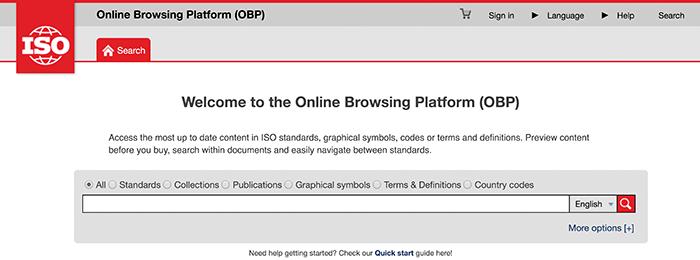
IEC has a technical committee 62 (TC 62) that is in charge of the IEC 60601/80601 series of standards, and its four sub‑committees (SC 62A – SC 62D) develop the series of standards and related standards. Table 1 shows a partial listing of many of the TCs and SCs that I track to keep up to date on the IEC 60601/80601 series of standards and technical reports along with related material.
Also, there are IEC joint working groups (JWGs) TC 62 / SC62A, B, and D that work with ISO TCs to develop 80601‑2‑XX particular standards (refer to Table 1) and other related standards and technical reports. Some of these JWGs are noted in Table 2.

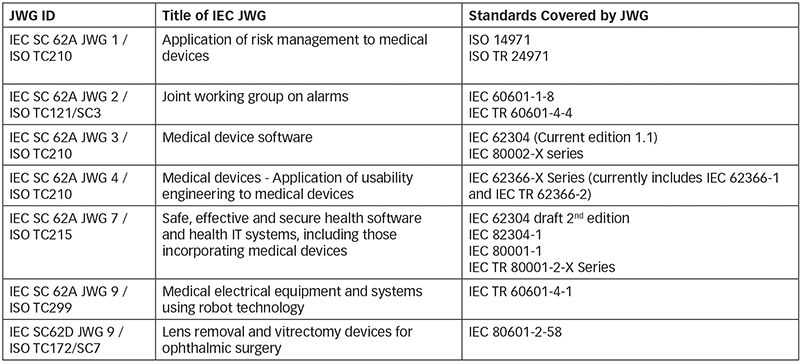
Figure 4 visually describes the interaction of the 60601‑1 series of standards that I describe in more detail.
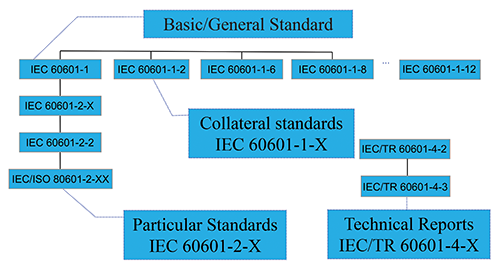
At the center of the universe for the medical electrical equipment and systems (MEE&S) standards of the IEC/ISO 60601/80601 series is IEC 60601‑1, “Medical Electrical Equipment – Part 1: General requirements for basic safety and essential performance.” IEC 60601‑1 is referred to as the General Standard in the Collateral and Particular Standards of the Series. The most current version of the General Standard is IEC 60601‑1:2005 + A1:2012 + COR1:2012 + ISH3:2013 + COR1:2014. All the standards in the Series point to or refer to the General Standard.
Collateral standards are horizontal standards that may apply to your specific device (assuming your device falls under the scope of IEC 60601‑1). IEC 60601‑1‑2 (Electromagnetic disturbances previously known as EMC) applies to all MEE&S under the scope of IEC 60601‑1. All other collaterals may apply to your device depending on your device’s intended use (which includes what environments it will be used in like home use, EMS use, etc.), if you need to meet Usability Engineering Process requirements (per IEC 60601‑1‑6), and if the regulator requires you to meet some or all of the Environmentally Conscious Design standard (IEC 60601‑1‑9). But, in general, only a couple collaterals typically apply to any specific device. Collateral standards either are: 1) used to bridge a gap between the requirements of the general standard and those of a sub group of MEE&S (i.e., IEC 60601‑1‑3, IEC 60601‑1‑11, and IEC 60601‑1‑12); or 2) deal with characteristics of MEE&S that are not fully covered by the general standard (i.e., IEC 60601‑1‑2, IEC 60601‑1‑6, and IEC 60601‑1‑8).
“Particular standards” in the series are vertical standards that may apply to your device if it has a specific focus, like infusion pumps and controllers (IEC 60601‑2‑24), surgical, cosmetic, therapeutic and diagnostic lasers (IEC 60601‑2‑22), high frequency surgical equipment (IEC 60601‑2‑2), cardiac defibrillators (IEC 60601‑2‑4) or endoscopic equipment (IEC 60601‑2‑18). Multiple particular standards may apply to a specific MEE&S such as multi‑function parameter monitors and ICU monitors which may include automated non‑invasive sphygmomanometers, also known as blood pressure monitors (IEC 80601‑2‑30), EKG (IEC 60601‑2‑27 or IEC 60601‑2‑47), among other functions that may be controlled under other particular standards. Particular standards may modify, replace or delete requirements contained in the general standard and collateral standards as appropriate for the particular medical electrical equipment. The particular standard may also add other requirements.
The “Technical reports” IEC/TR 60601‑4‑X are guidance documents that are informative (Guidance), whereas standards have normative requirements and informative (Guidance and Rationale) items too. For IEC standards, informative items can be in the base of the standard as in notes (typically) or in an annex. Some annexes are normative but typically most annexes are informative. Another way to look at informative is “for your information,” whereas normative is the norm of what is expected (required).
United States (U.S.)
For the U.S., the first place I always look for applicable standards is the FDA Recognized Consensus Standards database (Figure 5). I use this database so often I have set‑up a short cut to speed my way to the website www.accessdata.fda.gov/scripts/cdrh/cfdocs/cfStandards/search.cfm.
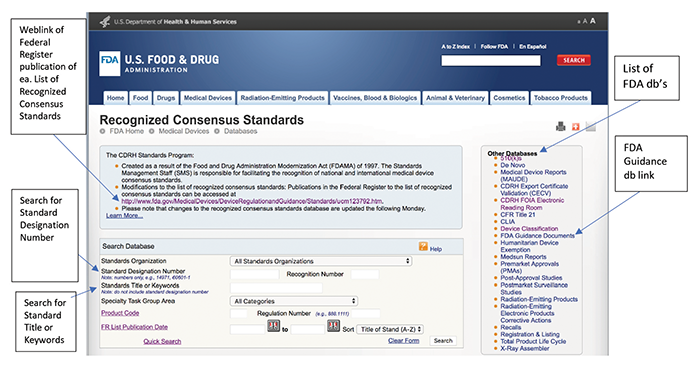
One point to know about this and most other FDA databases (see list in Figure 5 on the right side of the webpage) is that they are quite rigid, and if you don’t put in the exact term you may never find what you need. That is one of the reasons why I tend to search broadly. An example would be to search on ‘Standard Designation Number’ for 60601‑2 (typically yielding about 50 results) instead of 60601‑2‑2 (typically, about 15 results).
If I don’t know the applicable standard(s), I then search in the ‘Standard Title or keywords’ section (Figure 5). For example, ‘coexistence’ (i.e., competition between wireless devices) and ‘EMC’. For the ‘coexistence’ search results, shown in Figure 6, I found two standards which were published last year and added to the List of Recognized Consensus Standards (‘FR Publication Date’). Since these are newer standards, I want to make sure I know what FDA expectations are. So, let’s look at AAMI TIR69:2017 to determine if FDA has any restrictions on the standard and if the standard is linked with any FDA guidance documents or other requirements by clicking on the weblink for the ‘Title of Standard.’ Note, that some of the information on the FDA databases are not 100 percent accurate, so I will double‑check the Guidance database, if am not sure whether there are applicable guidance documents.

For AAMI TIR69:2017 (see Figure 7, this is an AAMI technical report), the FDA says that the complete standard applies for the ‘Extent of Recognition’ and the ‘Relevant FDA Guidance and/or Supportive Publications’ include two FDA Guidance documents – RF Wireless Technology in Medical Devices, and Information to Support a Claim of EMC of Electrically‑Powered Medical Devices.

Note that the dates of the Guidance Documents are prior to the publication of these two documents and when the two documents were published in the Federal Register (refer to FR Publication Date). So, the standards won’t be listed in the Guidance documents (many FDA Guidance documents list applicable standards at the time the Guidance is released as draft and updated when the Guidance is finalized but they are not always updated as it is a long process to get Guidances released), but the FDA will still expect you to consider the two FDA Recognized Consensus Standards when reviewing and applying the two Guidance documents. If you click on the link for the ANSI IEEE C63.27‑2017 standard it also refers to the same Guidance documents, as these two standards work together and were actually developed simultaneously.
The ‘EMC’ keyword search brought up 27 results (partial list shown for this example in Figure 8, but the total number of results are indicated in the upper left corner of the screen), including some that may seem surprising. You will see several ‘primary battery’ standards (at the top of the search results) because they are part of the Specialty Task Group Area Electrical Safety and EMC (ES/EMC). Many times, the results will show multiple standards like national and international standards, plus if a transition period applies you may get two editions. A great example is shown in the ‘EMC’ keyword search near the bottom of this example in the last five rows there are four results for 60601‑1‑2. That is because the FDA is still accepting 60601‑1‑2, 3rd edition (2007) but also accepts 4th edition (2014) of this standard. Additionally, there is a transition date for 3rd edition of 60601‑1‑2 as it won’t be a Recognized Consensus Standard past December 31, 2018. So, as of January 1, 2019, 60601‑1‑2, 3rd ed. won’t be Recognized by the FDA anymore.
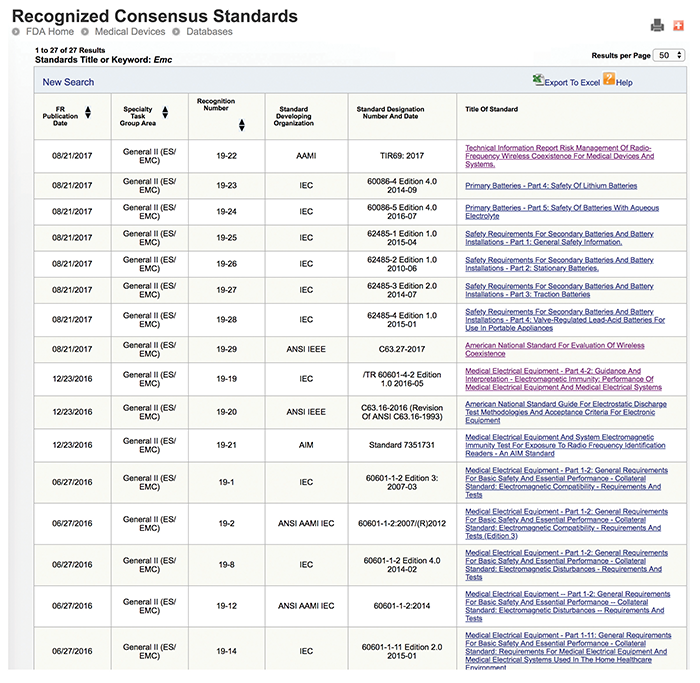
That covers the FDA database. For other U.S. national standards, you might also want to check the websites of AAMI, ANSI, UL, IEEE and ASTM. In the first FDA standards database slide (Figure 5) you can also search by ‘Standards Organization.’ As you can see, the FDA accepts some international standards and sometimes has accepted both international and national standards (like in the 60601‑1‑2 case).
Canada
Let’s go north to look at Canada. There is no database of standards for Health Canada but instead there is a list of standards called the ‘List of Recognized Standards for Medical Devices’ at www.canada.ca/en/health‑canada/services/drugs‑health‑products/medical‑devices/standards/list‑recognized‑standards‑medical‑devices.html. The original list was adopted back in 2002. It was last revised September 19, 2016 with an effective date of October 25, 2016. The list is divided into a couple sections. The first major section lists the changes made to the list including which standards are added, updated and removed. So, when searching this list be careful you know what section you are in. The other major section is the List of Recognized Standards which is subdivided into specialties like ‘Electromedical,’ ‘Radiology,’ and ‘Dental.’ An important point regarding Health Canada; if you check this list there are the Canadian and IEC versions of 3rd ed. and edition 3.1 (3rd ed. + Amendment 1) of 60601‑1 on the list of standards that are considered acceptable.
The FDA has transitioned such that only the U.S. national version of 60601‑1 edition 3.1 is on their list of Recognized Standards (AAMI ES60601‑1:2005/(R)2012 + A1:2012 + C1:2009/(R)2012 + A2:2010/(R)2012). The 3rd edition of 60601‑1 is not on the FDA’s list of Recognized Consensus Standards anymore. Near the top of the Health Canada Notice for the List of Recognized Standards for Medical Devices, it states the same transition time period that the FDA has for IEC 60601‑1‑2, 4th edition. Canada, the U.S. and the EU are all in line with the transition to IEC 60601‑1‑2, 4th edition (the EU and the U.S. refer to national versions, Canada and the U.S. refer to IEC) of December 31, 2018. Health Canada says they will not accept declarations of conformity to the 3rd edition after December 31, 2018.
Another resource I rely on for Canadian Standards is looking at the Standards Council of Canada databases for national and international standards. I sometimes use this database for non‑Canadian projects where I want to find a medical device standard I can’t find elsewhere. Canadian hospitals often seem to be more current regarding their knowledge of relevant medical device requirements than their U.S. counterparts. So, the Standards Council of Canada database seems to have medical standards not in other countries
(see www.scc.ca/en/search/standardsdb). In this database you can find if a standard is current or withdrawn which does not always line up with the standards in the Health Canada list.
I also want to make sure to look through the Guidance Documents on the Health Canada website for applicable guidances that may apply to the device I am dealing with. Refer to www.canada.ca/en/health‑canada/services/drugs‑health‑products/medical‑devices/application‑information/guidance‑documents.html for a list of these guidances. An interesting note: Health Canada has a Notice on this webpage for the “Use of United States Food and Drug Administration (FDA) Guidance Materials to support Canadian Medical Devices License Applications” (go to www.canada.ca/en/health-canada/services/drugs-health-products/medical-devices/application-information/guidance-documents/notice-use-united-states-food-drug-administration-guidance-materials-support.html). It is a very short notice where Health Canada states:
“The FDA regularly publishes guidance documents that outline recommendations regarding the technical performance assessment data for a variety of medical devices that are useful to device manufacturers. Health Canada encourages manufacturers to reference FDA technical guidance documents on topics where no similar Health Canada guidance is available.” (my emphasis)
So in many cases I rely on the FDA guidances that I deal with on a regular basis. Makes my life and that of my clients a lot simpler.
European Union (EU)
For the EU MDD, the first place I go is to the Harmonized List of Standards at http://ec.europa.eu/growth/single‑market/european‑standards/harmonised‑standards/medical‑devices. (Note, that the official list of Harmonized Standards is published in the Official Journal of the European Union (OJ), but it is much easier to use this link.)
An issue that has been very problematic under the MDD harmonization process is that the EU Commission has held up many 60601/80601 series and related standards from being harmonized because the Commission isn’t accepting the Annex ZZ (required for harmonization) that shows the relationship between the Essential Requirements, Annex I, of the MDD and the standard. This has caused a huge backlog of standards that require harmonization while we are in transition with the MDR. So, it is unlikely that most of the 60601/80601 standards that require harmonization will go through the MDD harmonization process, as available resources are being re‑focused on what is required for the MDR.
This means that a manufacturer needs to decide what is considered ‘State of the Art’ when it comes to harmonized standards that are outdated versus what the MDD requires per Annex I, of the Essential Requirements (‘State of the Art’). I inform my clients of the situation and point them to the more current CENELEC, CEN, IEC, or ISO version. At that point, I ask my clients to confer with their Notified Body to confirm if they will accept the more recent CENELEC, CEN, IEC, or ISO version of the standard, as applicable, and if there is anything else they will need to do, like any gap assessment with the harmonized standard. Once ratified, CEN and CENELEC standards are made available to the national standards organizations throughout the EU (e.g., the British Standards Institute in the UK) and are given until the date of Publication to publish the standard in their country.
A small sampling of this backlog is summarized in Table 3, along with the level of discrepancy between the MDD harmonized standard and ‘State of the Art’ standard to show compliance with Annex I, Essential Requirements.
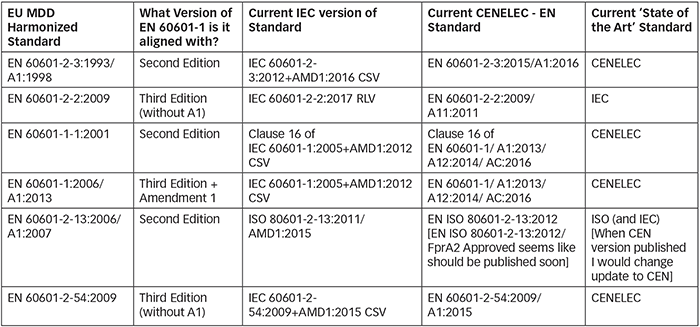
From Table 3 you can see it is critical to check the CENELEC and CEN databases to determine the most current version of an applicable standard. And, in some cases, you may need to go up one more level to IEC or ISO.
I also check the MEDDEV guidances, consensus statements, and informative documents (a list of these documents can be found at https://ec.europa.eu/growth/sectors/medical‑devices/guidance). Additionally, I check if any of the implementing acts have impact on the device, which is at the bottom of the webpage https://ec.europa.eu/growth/sectors/medical‑devices/regulatory‑framework_en. Then we need to consider other directives and regulations, such as the Battery, RoHS, REACH, and General Data Protection Regulation. Other sites I check are the Team NB (The European Association for Medical devices of Notified Bodies) which is a quasi‑trade organization for Notified Bodies, the Notified Body Operation Group and the Competent Authorities for Medical Devices.
Also, it is important to look at what else is going on, and one great resource is the International Medical Device Regulators Forum (www.imdrf.org) which replaced the previous Global Harmonization Task Force on Medical Devices (GHTF). The older GHTF documents are still available at the bottom of the documents tab on the IMDRF website. The IMDRF has worked on many topics from Software as a Medical Device (SaMD), Essential Principles of Safety and Performance of Medical Devices and IVD Medical Devices, MDSAP issues, Uniform Device Identification, and much more. They describe their group as “… a voluntary group of medical device regulators from around the world who have come together to build on the strong foundational work of the … GHTF and aims to accelerate international medical device regulatory harmonization and convergence.”
Conclusion
I want to make sure my clients (medical device manufacturers) have the information they need to make proper decisions to be able to develop their products and meet all the changing standards, requirements, quality system requirements and regulations that are imposed on them. I also, want to make sure they know what changes are ahead so they are able to plan effectively.
As we have seen from this small snapshot, the world of medical electrical device standards and regulations has grown significantly in the last decade(s), along with the technology of these devices. This has led to an explosion in the number of standards, guidance documents and changing regulatory schemes around the world with which medical device manufacturers need to comply. Clearly, device manufacturers must stay current on the changing compliance landscape, as well as new standards, guidances and regulations now under development.
All this hard work that manufacturers do in advance will help them in their strategic planning to come up with a great regulatory strategy for their products. A great regulatory strategy should include an understanding of the standards, regulations, pathways and guidances that apply to their products. In this way, they will have as smooth a process as possible in achieving timely market access and reducing the risk of being bogged down by retesting or product redesign.
Endnote
- For the FDA (USA), Health Canada, and the EU MDD standards are voluntary but if you don’t use the standards listed in these regulatory schemes you have a really high burden of proof you need to meet to satisfy the regulator or EU Notified Body if you go a different route.
 Leonard (Leo) Eisner is principal medical device product safety and regulatory consultant at Eisner Safety Consultants, which specializes in helping medical device manufacturers through product safety, international regulatory and quality system processes. Eisner’s focus is on active medical electrical equipment. Eisner is currently on several IEC TC 62 / SC 62A committees MT28 (Electrical Hazards), MT 30 (Overheating, fire protection and additional hazards) and WG14 (In charge of IEC 60601-1 Interpretations) that are working on the draft IEC 60601-1, 3rd edition + Amendment 2 project, is the US co-chair of IEC SC62D (majority of IEC 60601-2-xx & IEC/ISO 80601-2-xx standards), convener of IEC SC62D JWG9 (IEC/ISO80601-2-58) and a committee member of US TAG for TC62, SC62A, SC62D, & SyC AAL (Active Assisted Living System Committee – Home use medical and non-medical devices). Eisner Safety Consultants publishes an Annual Standards Trends Report for medical electrical device standards and related standards. He is also a registered professional engineer in safety and has over 30 years experience in product safety. Eisner is a member of RAPS, AAMI, ASQ, and the IEEE and the manager of the LinkedIn discussion group IEC 60601 Series – Medical Electrical Equipment. He can be reached at Leo@EisnerSafety.com
Leonard (Leo) Eisner is principal medical device product safety and regulatory consultant at Eisner Safety Consultants, which specializes in helping medical device manufacturers through product safety, international regulatory and quality system processes. Eisner’s focus is on active medical electrical equipment. Eisner is currently on several IEC TC 62 / SC 62A committees MT28 (Electrical Hazards), MT 30 (Overheating, fire protection and additional hazards) and WG14 (In charge of IEC 60601-1 Interpretations) that are working on the draft IEC 60601-1, 3rd edition + Amendment 2 project, is the US co-chair of IEC SC62D (majority of IEC 60601-2-xx & IEC/ISO 80601-2-xx standards), convener of IEC SC62D JWG9 (IEC/ISO80601-2-58) and a committee member of US TAG for TC62, SC62A, SC62D, & SyC AAL (Active Assisted Living System Committee – Home use medical and non-medical devices). Eisner Safety Consultants publishes an Annual Standards Trends Report for medical electrical device standards and related standards. He is also a registered professional engineer in safety and has over 30 years experience in product safety. Eisner is a member of RAPS, AAMI, ASQ, and the IEEE and the manager of the LinkedIn discussion group IEC 60601 Series – Medical Electrical Equipment. He can be reached at Leo@EisnerSafety.com
